
There are around 55,000 coffee shops in the United States. Almost a quarter of this number (11,600) belongs to the Starbucks chain. That’s an awful lot of lattes and frappuccinos. My home town, Boulder, has around 250, which for a small city of 100,000 is a substantial number, and luckily, for the most part, they’re gloriously independent and funky.
Coffee shops, coffeehouses and cafés now encircle the globe like rampant dandelions. But before the increasingly homogenizing effect of chains like Starbucks (in the US) and Costa Coffee (in the UK) coffee shops played a key role in the social fabric of our urban jungles. For hundreds of years coffee shops have been places to read, meet and discuss issues of the day.
Records show the first coffeehouses appeared in Damascus and Egypt in the early-16th century. Patrons gathered there to discuss politics, to listen to their local storytellers and musicians, and, of course, to drink coffee. While coffee shops are often denigrated as symptoms of urban gentrification or as remote office locations for armies of gig economy workers, others call them home — they’re still, after all, places for refuge, conversation and real social interaction. Save me a skinny latte!
From the Guardian:
It’s a bright February morning at the Proud Archivist (now the Proud East), a coffee shop facing the canal just off Kingsland Road in London, and regular Matthew Green is greeting the manager as if they’re old friends. Their cheerful interaction rises above the low din of the subdued crowd, some of whom are chatting, most of whom are typing away on laptops.
The fact that the Proud East is one of about five similar cafes within a five-minute walk in this Dalston neighbourhood brings to mind the fact that, in the past decade or so, the words: “There are a lot of coffee shops opening up around there” has become a precursor for: “There goes the neighbourhood.”
But if Green – who as well as being a regular is also a coffee historian, earned his PhD from Oxford and leads historical coffee tours around London – had his way, coffee houses like the Proud East would help facilitate something entirely different than gentrification: meaningful interaction.
One can almost imagine Green walking into a late 17th-century London coffee house and uttering the salutation that, he says, was de rigueur: “What news have you?” Today, it’s fair to say that’s been replaced by a more modern (and loathed) version: “What’s the WiFi password?”
However, as the coffee shop has become a byword for what everyone hates about urban change and gentrification – first come the creatives and their coffee shops, then the young professionals, then the luxury high-rises and corporate chains that push out original residents – it’s worth asking if that charge is fair. As the function of the coffee house in London has evolved over time, was its early iteration so radically different than the ones many of us type and sip away in today?
To hear Green tell it, there have been three major spikes in speciality coffee culture in the UK over the past 350 years. The first began when a Greek man, Pasqua Rosée, opened the first coffee house in 1652 against the stone wall of St Michael’s churchyard near Cornhill in London. That sludge-like coffee, Green says, was in keeping with the Turkish proverb: “Black as hell, strong as death, sweet as love.”
Over the next 50 years, as the coffee house became a popular alternative to taverns and alehouses, they also became something else: a place for London’s “coffee house politicians” to air their grievances. One could argue that these intelligentsia and knowledge economy workers – Samuel Peyps and Sir Isaac Newton were regulars – were not too dissimilar to the types of freelancers and creative class workers we find in places like The Proud East today. But instead of ranting on Twitter or in the comments section of newspapers, Green says patrons of London’s early coffee houses revelled in the novelty of boisterously voicing their opinions to their (almost exclusively male) companions.
Read the entire article here.
Image: Istanbul cafe, watercolor, created 1850-1882. Courtesy: Amedeo Preziosi / Wikipedia. Public Domain.
